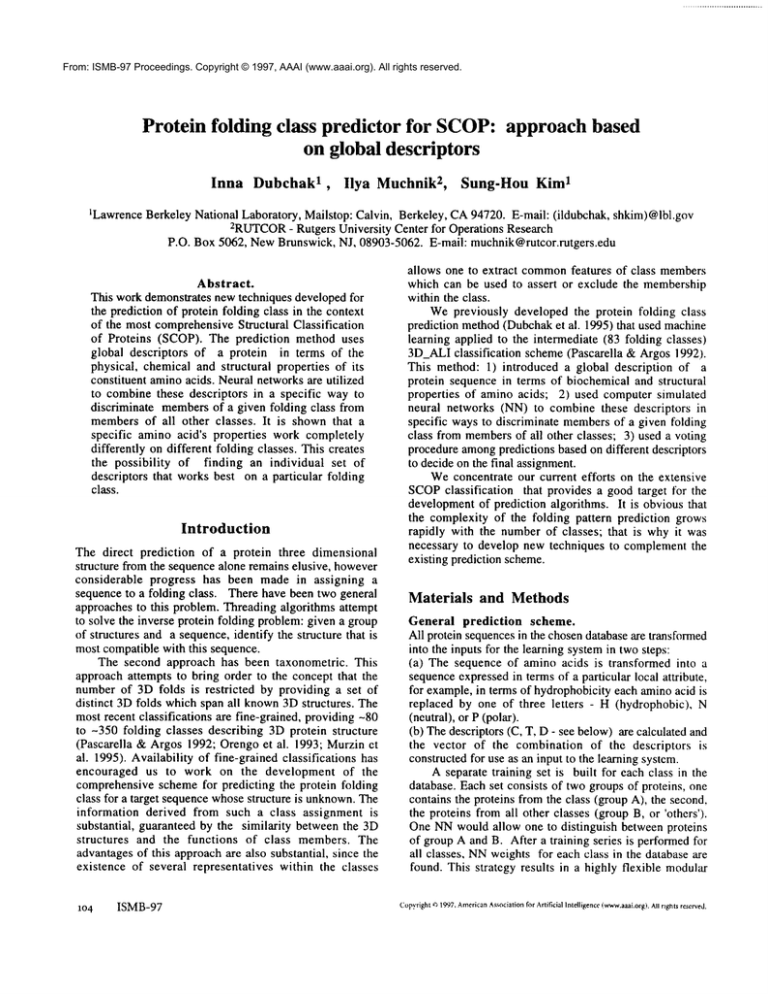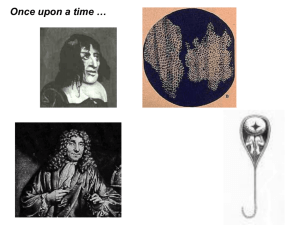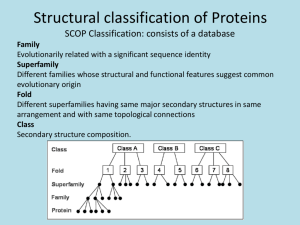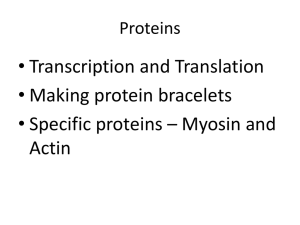
From: ISMB-97 Proceedings. Copyright © 1997, AAAI (www.aaai.org). All rights reserved.
Protein folding class predictor for SCOP:approach based
on global descriptors
lnna
Dubchak I ,
llya
Muchnik 2,
ISung-Hou
Kim
tLawrence Berkeley National Laboratory, Mailstop: Calvin, Berkeley, CA94720. E-mail: (ildubchak, shkim)@lbl.gov
2RUTCOR
- Rutgers University Center for Operations Research
P.O. Box 5062, NewBrunswick, NJ, 08903-5062. E-mail: muchnik@rutcor.rutgers.edu
Abstract.
This work demonstrates new techniques developed for
the prediction of protein folding class in the context
of the most comprehensiveStructural Classification
of Proteins (SCOP). The prediction method uses
global descriptors of a protein in terms of the
physical, chemical and structural properties of its
constituent aminoacids. Neural networksare utilized
to combine these descriptors in a specific way to
discriminate membersof a given folding class from
membersof all other classes. It is shown that a
specific amino acid’s properties work completely
differently on different folding classes. This creates
the possibility of finding an individual set of
descriptors that works best on a particular folding
class.
Introduction
The direct prediction of a protein three dimensional
structure from the sequence alone remains elusive, however
considerable progress has been made in assigning a
sequence to a folding class. There have been two general
approaches to this problem. Threading algorithms attempt
to solve the inverse protein folding problem:given a group
of structures and a sequence, identify the structure that is
most compatible with this sequence.
The second approach has been taxonometric. This
approach attempts to bring order to the concept that the
number of 3D folds is restricted by providing a set of
distinct 3Dfolds which span all known3Dstructures. The
most recent classifications are fine-grained, providing -80
to -350 folding classes describing 3D protein structure
(Pascarella & Argos 1992; Orengo et al. 1993; Murzin et
al. 1995). Availability of fine-grained classifications has
encouraged us to work on the development of the
comprehensive scheme for predicting the protein folding
class for a target sequencewhosestructure is unknown.The
information derived from such a class assignment is
substantial, guaranteed by the similarity between the 3D
structures and the functions of class members. The
advantagesof this approachare also substantial, since the
existence of several representatives within the classes
104
ISMB-97
allows one to extract commonfeatures of class members
which can be used to assert or exclude the membership
within the class.
Wepreviously developed the protein folding class
prediction method(Dubchaket al. 1995) that used machine
learning applied to the intermediate (83 folding classes)
3D_ALIclassification scheme(Pascarella & Argos 1992).
This method: 1) introduced a global description of
protein sequence in terms of biochemical and structural
properties of amino acids; 2) used computer simulated
neural networks (NN) to combine these descriptors
specific ways to discriminate membersof a given folding
class from membersof all other classes; 3) used a voting
procedure amongpredictions based on different descriptors
to decide on the final assignment.
Weconcentrate our current efforts on the extensive
SCOPclassification that provides a good target for the
developmentof prediction algorithms. It is obvious that
the complexity of the folding pattern prediction grows
rapidly with the numberof classes; that is whyit was
necessary to develop new techniques to complementthe
existing prediction scheme.
Materials
and Methods
General prediction scheme.
All protein sequencesin the chosendatabase are transformed
into the inputs for the learning systemin two steps:
(a) The sequence of amino acids is transformed into
sequenceexpressed in terms of a particular local attribute,
for example, in terms of hydrophobicityeach aminoacid is
replaced by one of three letters - H (hydrophobic),
(neutral), or P (polar).
(b) The descriptors (C, T, D - see below)are calculated
the vector of the combination of the descriptors is
constructedfor use as an input to the learning system.
A separate training set is built for each class in the
database. Eachset consists of two groups of proteins, one
contains the proteins from the class (group A), the second,
the proteins from all other classes (group B, or ’others’).
One NNwould allow one to distinguish between proteins
of group A and B. After a training series is performedfor
all classes, NNweights for each class in the database are
found. This strategy results in a highly flexible modular
Copyright~3 1997,AmericanAs.~ociationfor Artificial Intelligence (w~w.aaai.orS).All rights reserved.
system for recognition where adding more classes to the
classification does not require an extensive retraining of the
whole system.
Database
The database for protein fold recognition that did not
contain highly homologous proteins and adequately
represented SCOPclassification was created on the basis of
35% cutoff PDB_select set (Hobohm & Sander 1994).
Thesesets are non-redundantlists of PDBsequences each at
a different cutoff of pairwise protein similarity. After
removing SCOPclasses represented by only one protein
and the classes of designed polypeptidesthe database for all
our calculations contained607 proteins from those listed in
the 35%PDB_select file. These proteins represented 128
folding classes of SCOP(as of 09/1996 (Murzin et al.
1995)).
Global sequence descriptors.
Our approachconsists in using the association of local and
global information about amino acid sequences. We
developed the representation for a protein sequence that
includes a small number of descriptors based on various
physico-chemicaland structural properties of aminoacids,
Weused three descriptors, "composition"(C), "transition"
(T), and "distribution"
(D), to describe the global
composition of a given local amino acid property in a
protein, the frequencies with which the property changes
along the entire length of the protein, and the distribution
pattern of the property along the sequence, respectively. It
was shown(Dubchaket al. 1995) that the introduction
new ’transition’
and ’distribution’
characteristics
significantly enhancedprotein folding class prediction.
In this study the vectors of descriptors for all
attributes described in the next section contained 21 scalar
components. The 20 - dimensional vectors of amino acid
composition were also used as descriptors of protein
sequences.
Amino Acid Attributes
The 20 amino acids have different physical, chemical and
biochemical properties such that the same segment of the
protein chain can be described by a variety of property
patterns. It is shown(Selbig, Kaden& Koch 1992) that
structurally meaningfulproperties are often not explicit and
intermingle with other properties. That is whyit is critical
to study as manyamino acid properties and their mutual
combinationsas possible. Weselected properties from all
the main clusters of aminoacid indices (Tomii &Kanehisa
1996).
The most accurate-to-date protein secondary structure
prediction by Rost and Sander (Rost & Sander 1993)
obtained by PHDE-mail server (Rost, 1996) was utilized
in our study. This method gives predicted secondary
structures (PHD_SS)as three-state models: helix, strand,
and coil. Grouping of amino acids based on the other
properties was arbitrary. Weused the numerical scale of a
particular property and separated the 20 aminoacids into
three groups of approximatelyequal size according to their
numerical values on this scale. The ranges of these
numerical values for all selected groups of amino acids
taken from the original papers are shownin Table 1.
Neural Networks
Three layer feed forward NNwith weights adjusted by the
conjugate gradient minimization technique using the
BIOPROP
software (Muskal & Kim1992) were used. Ninp
was equal to 20 for percent composition of amino acids
and 21 for all other attributes, Nhid was equal to 1 and
Nout was equal to 2. High activity output to one node
indicated assignmentto a particular class, and high activity
to another node- inclusion to the groupof ’others’.
Table 1. Aminoacid attributes and the classification of aminoacids into three groupsaccording to the attribute.
Property
Group 1
Group 2
Group 3
Hyrophobicity
(Chothia &Finkelstein, 1990)
Polar
R,K,E,D,Q,N
Neutral
G,A,S,T,P,H,Y
Hydrophobic
C,V,L,I,M,F,W
Normalized van der Waals volume
(Fauchere, 1988)
0 - 2.78
G,A,S,C,T,P,D
2.95 - 4.0
N,V,E,Q,I,L
4.43- 8.08
M,H,K,F,R,Y,W
............................................Polarity (Grantham,
1974)
4.9
- 6.2
......................
L,I,F,W,C,M,V,Y
8.0-~9.2 ..............
P,A,T,G,S
"-10_4---13-0..........
H,Q,R,K,N,E,D
Polarizability (Charton &Charton,1982)
0 - 0.108
G,A,S,D,T
0.128 - 0.186
C,P,N,V,E,Q,A,L
0.219 - 0.409
K,M,H,F,R.Y,W
Normalizedfrequency of alpha-helix
(Chou & Fasman, 1978)
0.57 - 0.83
G,P,N,Y,C,S,T
0.98 - 1.08
R,H,D,V,W,I
1.11 - 1.51
Q,F,K,L,A,M,E
Dubchak
lo5
whichdid not participated in training. Twotraining sets and
two corresponding testing sets were assembled for the
prediction of each class in terms of every attribute, and
accordingly two neural networks were trained. In total 128
* 2 = 256 training-testing sessions were performed to
estimate a performance of a particular attribute. Both
training and testing set contained N/2 (N-number of
proteins in a particular class) proteins of the class and (607N)/2 proteins in the group’others’.
Results and discussion
Testing new attributes
In order to build testing sets, each of 128 classes was
shuffled by a random permutation and divided into two
equal parts. One half of its sequences was included in the
training set, the other half wasinvolvedin testing, and vice
versa. Thus, the testing was performed on the proteins
Table 2. Predictions at a 60%and higher accuracy for different aminoacid attributes.
Attribute
Nameof the folding class
in SCOP
Number of Correct
proteins
positive
in the class
%
Correct
negative
%
........................................................................................................
PHD_SS
Alpha; Globin-like
Alpha; Longalpha-hairpin
Alpha; lambdarepressor-like DNAbind.
Alpha; Oligomersof long helices
Beta; Immunoglobulin-like
A/B; beta/alpha (TIM)-barrel
A/B; FAD( NAD)-binding motif
A+B;Ribonuclease A-like
A+B; SH2-1ike
A+B;Histidine-containing
Multi; Sugar phosphatases
Small; Smallinhibitors, toxins, lectins
Small; BPTI-like
Small; EGF-like module
Alpha; DNA-binding3-helical bundle
Alpha; lambda repressor-like DNAbind.
Alpha; EF-hand
Beta; Immunoglobulin-like
Beta; Viral coat and capsid proteins
A/B; Periplasmic bind. protein-like
Small; Metallothionein
13
3
5
3
30
29
11
3
3
2
3
14
3
4
12
5
6
30
16
11
3
Hydrophobicity
A/B; PLP-dependenttransferases
A/B; Periplasmic binding protein-like
Small; Small inhibitors, toxins, lectins
3
11
14
66.7
72.7
71.4
98.7
93. i
94.8
Van der Waals
volume
Alpha; DNA-binding3-helical bundle
Alpha; Pheromoneproteins
Alpha;Ferritin like
2
3
5
66.7
66.7
60.0
92.9
97.0
98.5
Polarizability
Alpha; Pheromoneproteins
A/B; beta/alpha (TIM)-barrel
7
29
66.7
62.1
99.7
82.5
Polarity
A/B; beta/alpha (TIM)-barrel
Small; Classic zinc finger
Small; Metallothionein
29
3
3
62.I
66.7
100.0
85.6
99.7
98.3
Alpha-frequency
Alpha; lambda repressor-like DNAbind.
Beta; Viral coat and capsid proteins
Small; Smallinhibitors, toxins, lectins
5
16
14
60.0
62.5
71.4
99.7
89.8
96.5
Percent Composition
of aminoacids
.............................................................................................................
lo6
ISMB-97
84.6
100.0
66.7
99.7
60.0
99.5
66.7
100.0
66.7
85.4
69.0
80.2
63.6
85.2
66.7
99.3
100.0 99.5
100.0 99.5
100.0 99.7
71.4
91.4
66.7
99.7
75.0
99.7
66.7
99.7
60.0
99.7
100.0 100.0
66.7
88.6
75.0
97.6
63.6
92.4
100.0 100.0
After testing two numbers were calculated for
combinedtesting sets - 1) the percentageof correct positive
predictions (numberof class memberscorrectly assigned to
its class) and 2) the percentage of correct negative
predictions or rejection accuracy (the numberof proteins
from the group’others’ correctly not assigned to the class).
This procedure was repeated for each class in terms of each
attribute.
The numberof classes predicted at a 60%and higher
accuracy level totaled 25 for all attributes (Table 2).
Amongthem 18 classes were predicted by only one
attribute, four classes by two attributes, and three classes
by three attributes.
The largest numberof classes (14) were predicted
PHD_SS.Amonglarger classes the best prediction was
made for the class of Globins, with a high positive
accuracy (84.6 %) and 100 % rejection accuracy. Classes
with a small numberof proteins (2 - 5) also demonstrate
extremely high level of rejection accuracy (99.3 - 100%).
Other bigger classes - Immunoglobulin-likebeta-sandwich,
(TIM)-barrel, FAD- binding motif, and Small inhibitors
have a muchlower rejection accuracy (80,2 - 91.4%), and
positive accuracy in the range of 63.6 - 71.4%.
The percent composition of amino acids provides a
significant correlation with the broad structural class of
proteins (Chou 1989). Our earlier work (Mayoraz,
Dubchak & Muchnik 1995) showed that percent
composition of amino acids possesses certain predictive
powerfor muchmore detailed classification. As seen from
the Table 2, the percent composition of amino acids
performed well on 7 classes, 6 of them having 5 or more
proteins.
The hydrophobicity attribute workedsatisfactorily on
three classes. Twoof them were alpha/beta classes (PLPdependenttransferases and Periplasmicbinding protein-like)
not predicted by any other attribute. Four other attributes
(the normalized van der Waals volume, polarity,
polarizability of aminoacid, and alpha frequency) worked
satisfactorily on eleven classes altogether, amongthem
three - Pheromoneproteins, Classic zinc finger, and
Ferritin were also uniquelypredicted.
This workdemonstrates that a specific attribute works
differently on different classes. It is necessaryto emphasize
the importanceof finding an individual set of descriptors
which works best amongall others on a particular folding
class in the comprehensiveclassification. The study shows
a possibility
of such a solution. A number of new
physical, chemical, and structural properties including
various hydrophobicityscales, as well as different types of
protein sequence descriptors should be studied in order to
increase the numberof classes for the recognition. Crossvalidation and blind testing will be necessary to develop a
final prediction scheme.
Acknowledgments. The authors thank Nikolai N.
Alexandrovfor providing them with the protein database,
Stanley Goldmanfor helpful discussions and Chris Mayor
for his assistance in the preparation of the manuscript.
References
Charton, M.; and Charton, B. I. 1982. The structural
dependence of amino acid hydrophobicity parameters. J.
Theor. BioL 99: 629-644.
Chothia, C.; and Finkeistein,
A. V. 1990. The
classification and origins of protein folding patterns. Annu.
Rev. Biochem. 59: 1007-1039.
Chou, P. Y. 1989. Prediction of Protein Structure and
Principles of Protein Conformation. NewYork, Plenum
Press. 549-586.
Chou, P. Y.; and Fasman, G. D. 1978. Prediction of the
secondary structure of proteins from their amino acid
sequence. Adv. Enzymol. 47: 45-148.
Dubchak,I.; Muchnik, I.; Holbrook, S. R.; and Kim, S.H. 1995. Prediction of protein folding class using global
description of aminoacid sequence. Proc. Natl. Acad. Sci.
USA 92: 8700-8704.
Fauchere, J. L.; Charton, M.; Kier, L. B.; Verloop, A.; and
Pliska, V. 1988. Aminoacid side chain parameters for
correlation studies in biology and pharmacology.Int. J.
Peptide Protein Res. 32: 269-278.
Grantham, R. 1974. Aminoacid difference formula to help
explain protein evolution. Science 185: 862-864.
Hobohm,U.; and Sander, C. 1994. Enlarged representative
set of proteins. Protein Science 3: 522-524.
Mayoraz,E.; Dubchak,I.; and Muchnik,I. 1995. Relation
between protein structure,
sequence homology and
composition of amino acids. Third International
Conferenceon Intelligent Systemsfor MolecularBiology.,
240-248, Cambridge, UK: AAAI/MITPress.
Murzin, A. G.; Brenner, S. E.; Hubbard, T.; and Chothia,
C. 1995. SCOP:A structural classification of proteins
databasefor the investigation of sequencesand structures. J.
Molec. Biol. 247: 536-540.
Muskal, S. M.; and Kim, S.-H. 1992. Predicting protein
secondary structure content: a tandem neural network
approach. J. Mol. Biol. 225: 713-727.
Orengo, C. A.; Flores, T. P.; Taylor, W. R.; and
Thornton, J. M. 1993. Identification and classification of
protein fold families. Prot. Engng.6: 485-500.
Rost, B. 1996. PHD:predicting one-dimensional protein
structure by profile-based neural networks. Methods
Enzymol. 266:545-549
Pascarella, S.; and Argos, P. 1992. A data bank merging
related protein structures and sequences. Prot. Engng. 5:
121-137.
Rost, B.; and Sander, C. 1993. Prediction of protein
secondary structure at better than 70%accuracy. J. Mol.
Biol. 232: 584-599.
Selbig, J.; Kaden, F.; and Koch, I. 1992. Applying
machine learning methods for finding significant amino
acid properties in proteins. FEBS3: 241-246.
Tomii, K.; and Kanehisa, M. 1996. Analysis of amino
acid indices and mutation matrices for sequencecomparison
and structure prediction of proteins. Prot. Eng. 9: 27-36.










